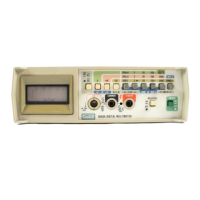OPERATION
RELATIVE MEASUREMENT
2.
A shorted transistor will produce an overrange
indication on the display.
2-76. Transistor Leakage Test
2-77.
Use
the following procedure to test transistors for
leakage
{ICEs):
1.
Install the transistor, and connect the test
fixture
to
the
8050A
(see
preceding
paragraphs).
2.
Set the switch on the test fixture to ICES.
3.
Select the conductance function, 2
mS
range on
the
8050A.
4.
A reading of more than
0.0020
(
6
µA)
indicates
a faulty transistor (silicon).
2-78. Transistor
Beta
Test
2-79.
Use
the following procedure to test the beta
of
a
transistor:
1.
Install the transistor and connect the test
fixture
to
the
8050A
(see
preceding
paragraphs).
2.
Set the switch in the test fixture to BET
A.
3.
Select the conductance function, 2
mS
range on
the
8050A.
4.
Note the display reading on the
8050A,
then
shift the decimal point three places to the right.
This will
be
the beta of the transistor.
NOTE
Beta
is
a temperature-sensitive measurement.
Allow sufficient timeforeach tested transistor
to stabilize. A void touching the transistor case
with
your
fingers
while
making
beta
measurements.
2-80.
Relative Measurement
2-81. The following paragraphs contain additional
information on and measurement techniques for relative
measurements.
2-82.
DECIBEL
(dB)
CIRCUIT GAIN OR LOSS
2-83.
The relative function of the
8050A makes it easy to
determine the gain or loss (in decibels)
of
a circuit.
By
using the relative function, any voltage level can be used
as
the
0
dB
reference point for
dB
measurements. Figure
2-13
describes how to use the relative function to measure
circuit gain or loss in
dBs.
2-16
2-84. AC
Voltage
and Current Measurement
2-85. The following paragraphs contain additional
information on and measurement techniques for ac
voltage and current measurements.
2-86.
TRUE-RMS MEASUREMENTS
2-87.
One
of
the most useful features of the 8050A
is
the
direct measurement
of
true-rms ac voltages and ac
current. Mathematically, rms
is
defined as the square root
of the mean of the squares of the instantaneous voltages.
In physical terms, rms
is
equivalent to the de value that
dissipates the same amount
of
heat in a resistor
as
the
original waveform. True-rms
is
the effective value of any
waveform and represents the energy level
of
the signal.
It
is
used directly in the relationships of Ohm's
Law and
provides a reliable basis for comparisons of dissimilar
waveforms.
2-88.
Most multimeters in use today have average-
responding ac converters rather than true-rms converters
like the
8050A.
Usually the gain in average-responding
meters
is
adjusted so that the reading gives the rms value,
provided the input signal
is
a harmonic-free sinusoid.
However, if the signal
is
not sinusoidal, the average-
responding meter does not give a correct rms reading.
2-89.
The
8050A
ac converter calculates the rms value
through analog computation. This means that
8050A
readings are accurate rms values for mixed frequencies,
modulated signals, square waves, sawtooths,
10%-duty-
cycle
pulses, etc.
2-90.
WAVEFORM
COMPARISON
(RMS
VS
AVERAGING METERS)
2-91. Figure 2-14 shows
the
relationship between
common waveforms and the display readings
of
the
8050A
compared to average-responding meters. Figure
2-
14
also illustrates the relationship between
ac
and de
measurements for ac-coupled meters.
For
example, the
first waveform (in Figure 2-14) is a sine wave with a peak
voltage of l.414V. Both the 8050A and the average
responding meters display the correct rms reading
of
l.OOOV
(thedccomponentequalsO). However, the l.414V
(peak) rectified square wave produces a correct de reading
(0.707V)
on both meters but only the 8050A correctly
measures the ac component
(0.707V).
The average
responding meter measures the ac component
of
the
rectified square as
0.785V,
which
is
an error of
5.6%.
2-92.
CREST FACTOR
2-93.
The crest factor
of
a waveform
is
the ratio
of
the
peak
to
rms voltage. In waveforms where the positive and
negative half-cycles have different peak voltages, the
higher voltage
is
used in computing the crest factor. Crest
factors start at
1.0
for a square wave (peak voltage equals
rms voltage).

